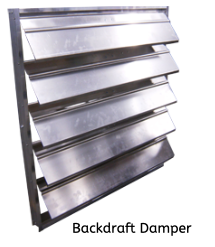Most industrial building ventilation systems designed by Eldridge incorporate louvers and backdraft dampers. Both are used to modify the free flow of air, but they have different purposes. In this article, we will discuss similarities, differences and purpose of each as well as the characteristics used to select the proper one for an application.
Similarities and Differences
It is not difficult to confuse louvers and backdraft dampers when they are used in a building ventilation system. From the outside of the building, they may look similar because they both can have an exterior frame and horizontal blades. Also, they are mostly located on building walls and can be used as either the supply or exhaust entry point for a ventilation system. But that is where the similarities end. The main physical difference between them is that backdraft damper blades are moveable while most louver blades are fixed. Another difference is their purpose. For building ventilation systems, louvers are primarily used to separate items from the air flow, such as sand, rain or snow, while backdraft dampers are primarily used to prevent air flow in one direction.
Backdraft Dampers
In a building ventilation application, backdraft dampers are sometimes referred to as shutters. The weight of the blades of a backdraft damper are used to restrict the flow of air in one direction. The most common application of a backdraft damper is on the outlet of a fan. When the fan is on, the air flow pushes the damper blades open and air flows in the desired direction. When the fan is off, the weight of the blades will return them to the closed position and air flow is prevented from flowing through the fan opening.
Backdraft dampers blades can also be calibrated with counter weights to open at a certain pressure. A good example is of this application is a ventilation system that has incorporated truck or man doors as the primary sources of supply or exhaust air. If some or all of these doors are closed, the backdraft damper will open at the set pressure level to allow air to flow and keep the inside pressure from building up to a potentially hazardous level.
Louvers
Louvers will mostly have fixed position blades which are designed for the purpose of separating items from the air flow. The three characteristics that go into determining which louver to use in a particular a pplication are penetration velocity, free area and pressure drop. The penetration velocity will determine the maximum speed of the air through the louver to keep out the undesired item. Because the most common use of a louver is to prevent water penetration, manufacturers will provide a table showing water penetration based on air velocity through the louver.
pplication are penetration velocity, free area and pressure drop. The penetration velocity will determine the maximum speed of the air through the louver to keep out the undesired item. Because the most common use of a louver is to prevent water penetration, manufacturers will provide a table showing water penetration based on air velocity through the louver.
The free area of a louver is important in determining the louver size that is required. As an example, let’s assume there is an application where we have an exhaust fan that is
moving 10,000 CFM. To keep out water at the air inlet, we have selected a drainable blade louver that has a 50% free area. Using a 1,000 feet per minute velocity limit for water penetration, we will need to have a 20 square feet or 54” by 54” of louver at the air inlet (10,000 CFM ÷ 1,000 ft/min ÷ .5 = 20 square feet).
The pressure drop caused by a louver is a function of the air velocity passing through the louver. The louver pressure drop will need to be added to the pressure drops caused by other ventilation system components when sizing the fan to ensure the fan is providing the desired volume of air.
Conclusion
We hope that this article has helped provide some clarity on the similarities and differences between louvers and dampers and how to pick the right one for your application.
